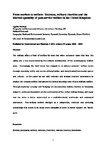From warfare to welfare: veterans, military charities and the blurred spatiality of post-service welfare in the United Kingdom
| dc.contributor.author | Herman, A | |
| dc.contributor.author | Yarwood, Richard | |
| dc.date.accessioned | 2016-09-21T12:15:00Z | |
| dc.date.available | 2016-09-21T12:15:00Z | |
| dc.date.issued | 2015-12 | |
| dc.identifier.issn | 0308-518X | |
| dc.identifier.issn | 1472-3409 | |
| dc.identifier.uri | http://hdl.handle.net/10026.1/5473 | |
| dc.description.abstract |
<jats:p>The military offers a form of welfare-for-work but when personnel leave they lose this safety net, a loss exacerbated by the rollback neoliberalism of the contemporary welfare state. Increasingly the third sector has stepped in to address veterans’ welfare needs through operating within and across military/civilian and state/market/community spaces and cultures. In this paper we use both veterans’ and military charities’ experiences to analyse the complex politics that govern the liminal boundary zone of post-military welfare. Through exploring ‘crossing’ and ‘bridging’ we conceptualise military charities as ‘boundary subjects’, active yet dependent on the continuation of the civilian-military binary, and argue that the latter is better understood as a multidirectional, multiscalar and contextual continuum. Post-military welfare emerges as a competitive, confused and confusing assemblage that needs to be made more navigable in order to better support the ‘heroic poor’.</jats:p> | |
| dc.format.extent | 2628-2644 | |
| dc.language | en | |
| dc.language.iso | en | |
| dc.publisher | SAGE Publications | |
| dc.subject | military geography | |
| dc.subject | welfare | |
| dc.subject | veterans | |
| dc.subject | transition | |
| dc.subject | military charities | |
| dc.subject | boundaries | |
| dc.title | From warfare to welfare: veterans, military charities and the blurred spatiality of post-service welfare in the United Kingdom | |
| dc.type | journal-article | |
| dc.type | Journal Article | |
| plymouth.author-url | https://www.webofscience.com/api/gateway?GWVersion=2&SrcApp=PARTNER_APP&SrcAuth=LinksAMR&KeyUT=WOS:000366667200014&DestLinkType=FullRecord&DestApp=ALL_WOS&UsrCustomerID=11bb513d99f797142bcfeffcc58ea008 | |
| plymouth.issue | 12 | |
| plymouth.volume | 47 | |
| plymouth.publication-status | Published | |
| plymouth.journal | Environment and Planning A: Economy and Space | |
| dc.identifier.doi | 10.1177/0308518x15614844 | |
| plymouth.organisational-group | /Plymouth | |
| plymouth.organisational-group | /Plymouth/Faculty of Science and Engineering | |
| plymouth.organisational-group | /Plymouth/Faculty of Science and Engineering/School of Geography, Earth and Environmental Sciences | |
| plymouth.organisational-group | /Plymouth/Faculty of Science and Engineering/School of Geography, Earth and Environmental Sciences/SoGEES - Manual | |
| plymouth.organisational-group | /Plymouth/PS - Doctoral College | |
| plymouth.organisational-group | /Plymouth/REF 2021 Researchers by UoA | |
| plymouth.organisational-group | /Plymouth/REF 2021 Researchers by UoA/UoA14 Geography and Environmental Studies | |
| plymouth.organisational-group | /Plymouth/Users by role | |
| plymouth.organisational-group | /Plymouth/Users by role/Academics | |
| dc.identifier.eissn | 1472-3409 | |
| dc.rights.embargoperiod | Not known | |
| rioxxterms.versionofrecord | 10.1177/0308518x15614844 | |
| rioxxterms.licenseref.uri | http://www.rioxx.net/licenses/all-rights-reserved | |
| rioxxterms.type | Journal Article/Review |


